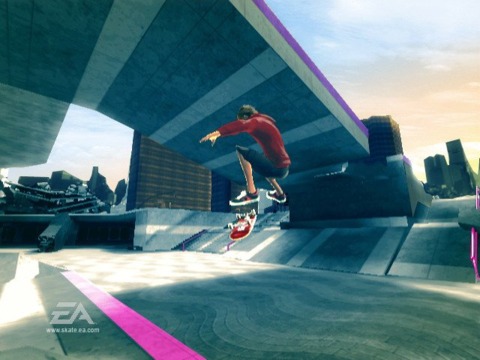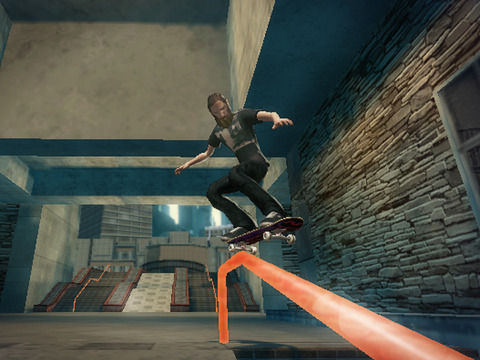
Skate It serves as a mid-point between the original game and the 2009 sequel, Skate 2. It seems that San Vanelona, the fictional city that serves as the backdrop for the original game, has been hit by a grip of unspecified disasters. This gives you a completely abandoned city to skate in. It also gives a bit of a story-justified reason for the ghost town feel of the entire game, which probably has a lot more to do with the limitations of the Wii than any sort of simple story stuff. Of course, you actually leave San Vanelona in Skate It, and there's no explanation for why cities like Paris or London don't have any people or cars on the streets. The barren nature of the world makes the game feel really dated, like it was some kind of PS1 port of a PS2 Tony Hawk game.
The control options are probably the most important thing about Skate It. You can choose from three different schemes. The most basic is a Remote-only scheme. You steer by tilting the Remote, and tricks are also governed by how you move the Remote. So if you tilt sideways and lift up, that's supposed to do a kickflip or heelflip. Circular motions, half-circles, and so on let you bust out the other tricks in the Skate It repertoire. In most cases, downward motions instead of upwards motions are supposed to let you do nollie versions of most of your tricks.
If you hook up a Nunchuk, you can move steering off of the Remote and over to the analog stick, which is better. Still, it doesn't really solve the core problem--getting the Wii Remote to translate your motions into the tricks you're attempting to perform at the precise time you're trying to perform them. Even busting out simple ollies with precise timing seems like random chance due to the temperamental nature of the hardware. You're left with the feeling that the developer tried to fit too many different motions onto the Remote. I found that the circular motions were much better about coming out on demand, so I found myself flipping into and out of just about anything I did.
The third control scheme uses the Remote and the Balance Board. Things like steering and manuals feel really natural with the board, but in this mode, you have to use the D pad on the Remote to toggle your way through multiple sets of tricks, then put pressure on specific sections of the board to perform them. While the steering and movement might work just fine for players who just want to skate around the world and do whatever, it doesn't really make for a very fun experience if you're trying to actually progress through the game's career mode.

The bulk of the game's voice comes from Giovanni Reda, the same professional skateboarding photographer and video guy who commentated the first game. Reda comes across as super-repetitive and obnoxious in Skate It. Also, you don't seem him skating around behind you or anything. It's like his voice is just in your head or something.
The developers probably really wanted to make sure that the animation in Skate It looked right. That's probably the best part about the way it looks--the tricks animate well and the skating generally looks realistic. But the rest of the game, from the player models to the textures, to the environments, just look kind of bad. Given that it's a Wii release, it's impossible to expect the Skate experience to move from 360/PS3 to the Wii with no compromises, but man... parts of this game are just downright ugly.
As with the original Skate, Skate It manages to feel authentic and it comes with some sharp ideas. But the game's presentation and control just don't pan out, and it seems like a game that'll frustrate players more often than not. If you're a Skate fan looking for what's next, do yourself a solid and wait for Skate 2.